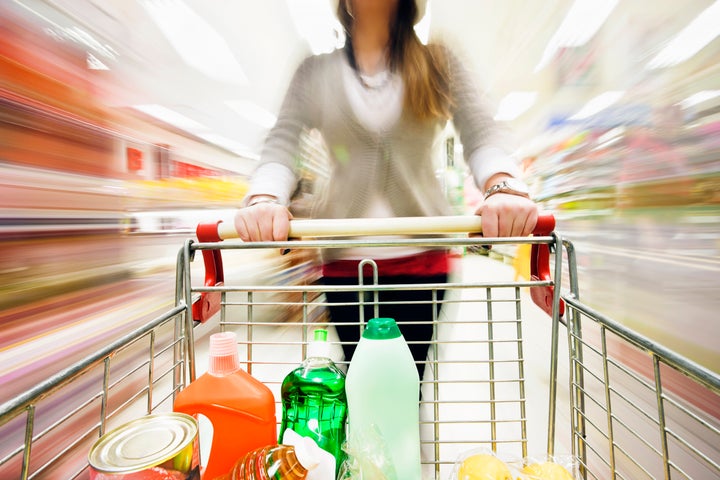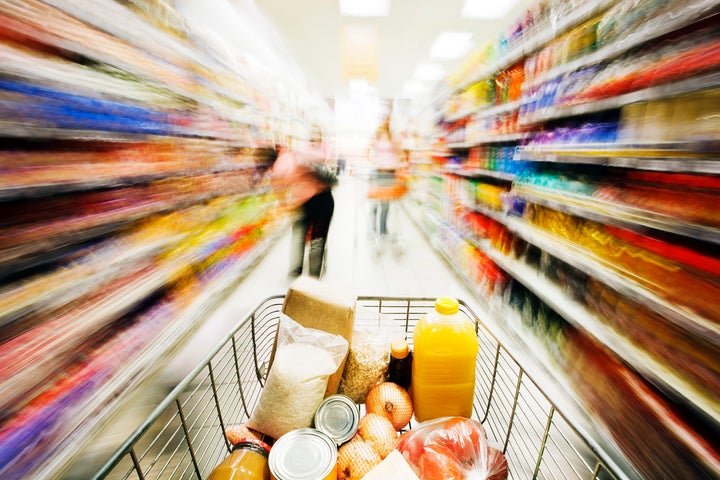Groceries are an essential part of life, but food shopping is no walk in the park for those with anxiety.
And that’s without a global pandemic. The coronavirus outbreak is sending shoppers to the store in doomsday-like droves. Packed aisles, noisy carts and decision-making overload ― which cause pit-in-the-stomach stress on an ordinary grocery trip ― are now at an all-time high. A general misunderstanding of how the virus spreads doesn’t help.
Even without an outbreak, psychologists can attest: Grocery store anxiety is absolutely real — and many are struggling with it now more than ever.
According to Kevin Chapman, a clinical psychologist who specializes in anxiety-related disorders, grocery store anxiety is common. Like other forms of anxiety, it stems from the inability to control the experience.
“The essence of anxiety is thoughts of uncontrollability and unpredictability of a future event,” Chapman told HuffPost. Grocery stores are filled with uncertainty — think parking spots, crowds, food decisions, malfunctioning self-checkout scanners and unbearable cashier lines. That’s why they’re a hotbed of anxiety triggers, Chapman said.
Supermarket industry expert Phil Lempert also attributes in-store stress to the overwhelming number of options. “If we take a look at an average store, it has about 40,000 different products,” he told HuffPost. While anxiety is not a top concern among grocers, they do have their eye on it. “What we’re seeing now, for example, is retailers curating offerings. They may not have 100 bottles of olive oil. They may have 10 that are more relevant.”
Grocery store anxiety is on a severity continuum.
While having fewer options can help those who struggle with decisions, it’s only a fraction of the larger problem — a problem that Chapman said affects shoppers across a spectrum of stress. “Grocery store anxiety is on a continuum,” he said. “On one end you have the people who can’t wait to go to the grocery store. On the other end would be the extreme cases, like agoraphobia.”
Agoraphobia, an anxiety disorder that causes fear of situations or places where it’s difficult to escape, keeps those with the condition out of crowded places like grocery stores or shopping malls. The National Institution of Mental Health estimates 1.3% of U.S. adults struggle with agoraphobia during their lives, which means that same percentage either suffers through grocery store trips or avoids the store altogether.

“Most people who avoid going places like the grocery store do so not necessarily because of, say, food selections, it has more to do with being in a place where escape might be difficult or embarrassing in the event of having a panic attack,” Chapman said.
According to the Mayo Clinic, agoraphobia often develops after a person has experienced a panic attack, which typically stems from a biological predisposition paired with “generalized and specific learning experiences that teach the individual to perceive the physical symptoms of fear as dangerous,” Chapman said. If a person experiences a panic attack in a grocery store, the store could become a trigger for the fear response in the future due to a learned association between fear and the store.
Can you overcome grocery store anxiety?
Lempert said stores across the country are attempting to curb anxiety through welcoming aesthetics. Some stores now use wood interiors, warm lighting and wall ivy to make shoppers more comfortable while muffling anxiety-triggering sounds like shopping carts and loud speakers. Others, like ShopRite, even offer in-store registered dieticians to help customers with food decisions.
While these adjustments are all well and good, Chapman said facing even the worst grocery stores head-on is the only long-term cure for this kind of anxiety.
“I’ll be bold and say it is fixable,” he said. “You can program the memory structure in your brain to see grocery stores as shrug emoji instead of ‘Jaws’ music. First, you have to change your anxious appraisals about the grocery store in and of itself.”
This is cognitive behavioral therapy at its core. Chapman tells his clients to pick more flexible, neutral thoughts about going to the grocery store. “It could be that the grocery store is not that crowded, or it is, but it’s not that big of a deal,” he said. “The generation of different thoughts leads me to be more confident in my approach.”
From here, he urges exposure therapy by facing the grocery store multiple times — in all types of circumstances (yes, even on Super Bowl weekend or Sunday afternoons). “Vary the day of the week, whether you’re going with or without someone, leaving your phone in the car — these are all variables that manage the associated distress,” he said.
Speaking of variables, Chapman is not a believer in solely shopping during off times or having a grocery buddy. This triggers what he describes as “safety signals,” which make anxious shoppers feel better in the moment, but can backfire in the long run. “It’s best to get used to any variable that occurs because it’s kind of like you’re saying to your brain, “Even if I face 25 variables — and I still don’t have a panic attack — that must mean grocery stores aren’t dangerous,” he said.

Chapman suggests a similar approach for his agoraphobia clients, although he recommends they confront their physical limitations, too. “If someone is sensitive to their heart racing [before grocery shopping], I might get that person to run in place for a whole minute before going to Kroger, because they’re confronting the symptoms and the situation,” he said.
Judgment is a lesser-known grocery store stressor.
According to Chevese Turner, chief policy and strategy officer at the National Eating Disorders Association, another form of grocery store anxiety stems from judgmental glances cast by fellow shoppers. This is particularly tough for those in higher-weight bodies, due to internal and external stigmas and pressures.
“People in higher-weight bodies tend to be anxious about grocery shopping because they know they’re going to be judged,” she said. “There are all kinds of nightmare stories out there, like people commenting on what the person is buying, or the silent judging.”
To help those struggling, Turner said a smile or non-food-related conversation with fellow shoppers could help. “If you notice someone is having a difficult time in the grocery store, have a positive conversation with them,” she said. “Don’t get into their business, just be friendly. It could make their day.”
And, even better? This type of positive and uplifting store interaction could curb your own grocery anxiety, too.